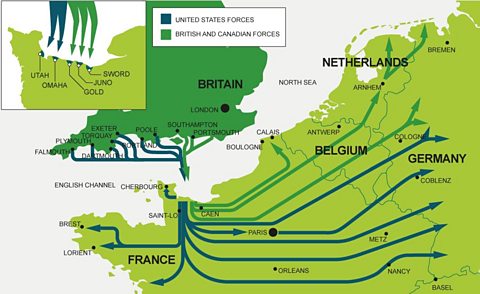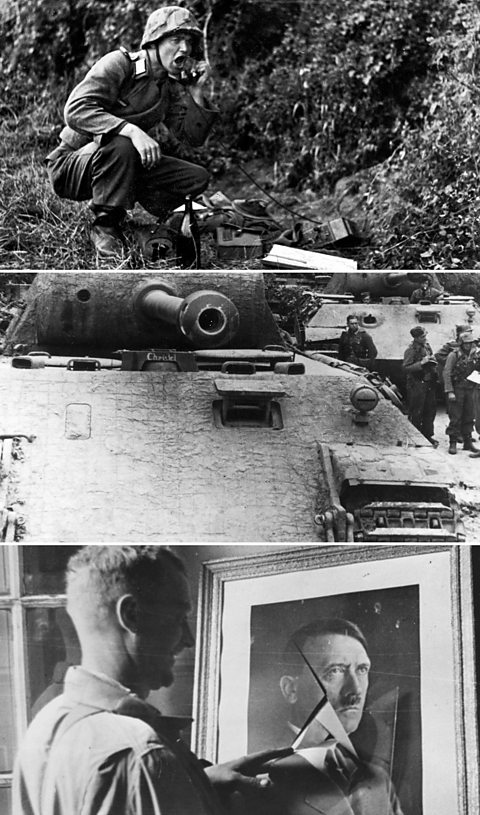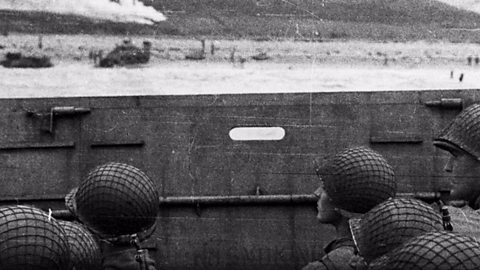EVEN THE BEST LAID PLANS
Presented by General Sir Richard Dannatt, former head of the British Army
In the early hours of the 6th June 1944, these huge guns opened fire on the coast of northern France.
It was H-Hour, on D-Day.
Nowadays, this vast ship, HMS Belfast, is moored by the banks of the River Thames in London. But on D-Day it was one of the first ships of the British and Allied invasion force that unleashed fury on the forces of Nazi Germany that lay just across the Channel.
If the invasion was successful, the battle to defeat Hitler would follow. The stakes could not have been higher.
The man in overall command was US General Dwight D. Eisenhower. He had been planning for this moment for over a year.
Now, like Eisenhower, I have sent men on life-threatening operations and I know what Eisenhower knew; that no plan, however well thought through, survives first contact with the enemy. When the first bullets flew, when the first boots hit the ground, he would have known that so much could have gone wrong.
What if the enemy forces were far stronger than expected? What if reinforcements arrived more quickly or in greater strength? What if the new technologies developed for D-Day failed? And what about the weather? No general can control that.
D-Day was a critical step in ending the war. But at the moment it began, failure was a real possibility.
IMAGES COURTESY OF GETTY IMAGES
Even the best laid plans
75 years ago this June, as night fell on D-Day, British and American Allied commanders could reflect on a day of overwhelming success. Over 150,000 British, US and Canadian soldiers had landed by air and sea and pushed their way several miles inland.
But what if the invasion hadn't gone to plan?
A problem with any of the vital elements - from keeping the invasion plans secret, to the complex operation that kept Allied troops supplied once they had landed - could have radically changed the outcome of D-Day.
The plan that needed to work
The invasion of northern France was the first stage in a long campaign to defeat Nazi Germany. The Allied commanders had to get every detail of the D-Day plan to work.

If the Germans had found out
The Germans were expecting an invasion - but they didn't know where and when. Events might have unfolded differently if details of the Allied plan had leaked out.
IF THE GERMANS HAD FOUND OUT
Presented by General Sir Richard Dannatt, former head of the British Army
German defences along the coast of north-western Europe were formidable. The Nazi general in charge of the so-called Atlantic Wall, Field Marshal Erwin Rommel, had made sure that there was artillery, concrete pillboxes for machine gunners, miles of barbed wire, anti-tank devices and minefields.
But most of the GermansÔÇÖ real firepower was concentrated in the Pas de Calais, where the English Channel is at its narrowest. This is where the Germans could see the English coast and where they expected the Allied invasion to come from.
And that is exactly what the Allies wanted. The weaker the defences in Normandy, the fewer Allied losses that there would be. And the further away German reinforcements were, the harder it would be for them to make a counter-attack.
So the Allies ran a complex deception plan to disguise where they intended to land. Double agents, and fake wireless transmissions, helped to convince Hitler and his commanders that a large force was being prepared in south-east England, ready to attack the Pas de Calais. The preparations even included inflatable tanks and landing craft.
But about a month before D-Day, one of RommelÔÇÖs commanders did propose that some armoured divisions and anti-aircraft divisions should be moved to Normandy. But that did not take place.
If the Germans had been forewarned then those divisions would be here and with greater firepower in place, perhaps Rommel would have prevented the Allies getting the beachheads that they needed.
The D-Day plan would have been compromised.
IMAGES COURTESY OF GETTY IMAGES
If the supply line had failed
Once the Normandy beaches were captured, massive reinforcements of troops, vehicles, equipment, food and fuel were needed. If this part of the plan had failed, would the whole invasion have been jeopardised?

Image caption, The Allies had built and brought over two artificial ports known as Mulberry Harbours to help supply the invasion. They were both operational by 18 June and could move up to 7,000 tonnes of vehicles and supplies per day.
1 of 7

If Hitler had realised what was happening
As the Allies attacked from the air and sea in the early hours of 6 June, local commanders gradually became aware that the long awaited invasion had begun.
But those at the very top of the Nazi command believed it might be a diversion, and the main attack was coming elsewhere.
Many of the strongest German reserves ÔÇô the armoured or 'Panzer' divisions ÔÇô were held back and only released by Hitler to move to Normandy to launch counter-attacks in the mid-afternoon when it was too late
If the order had come earlier in the day, D-Day might have turned out very differently
Cutting the Allies off
Local German commanders reacted quickly to the airborne invasion, calling for support from the 21st Panzer division which was the only German armoured reserve actually stationed in the invasion zone.
A rapid and concentrated counter-attack might have given them a greater chance of defeating the airborne forces as they landed, leaving the amphibiously landed forces without their flank protection when they came ashore a few hours later.
Defending Caen
The Allies wanted to take the strategically important city of Caen. Bad weather on D-Day persisted late into the morning, and poor visibility inland made it easier for the 21st Panzer Division to avoid aerial attacks.
Reach Caen early enough, and the battle with Allied infantry, weary from fighting their way up the beaches, could have been much more problematic for the Allies than it proved to be. This would have bought German commanders vital time to attempt to counteract the invasion.
Missed opportunities
Had German commanders ÔÇô among them Hitler himself ÔÇô all agreed this was the main invasion, the Panzer reserves might have been ordered to Normandy much earlier on D-Day, and the Allies might have faced a far greater challenge.
However, the Germans missed the chance to deploy their best defence forces effectively. But most of their decision-making was based on the belief that the main invasion would come further north. Inaccurate accounts of events on the front line added to the confusion; even at midday, senior German commanders believed it was their forces, not the Allies, who were winning the fight.


What if D-Day had failed?
The ultimate decision to launch the D-Day invasion was made by General Eisenhower. On issuing the order to go ahead he drafted a statement accepting full blame in the event of failure.
He wrote: "Our landings in the Cherbourg-Havre area have failed to gain a satisfactory foothold and I have withdrawn the troops. My decision to attack at this time and place was based upon the best information available. The troops, the air and the navy did all that bravery and devotion to duty could do. If any blame or fault is attached to the attempt it is mine alone."
He would never need to issue the statement, and it remained in his uniform pocket unnoticed for weeks. But what if he had? What if the huge invasion force had been repelled? What if D-Day had failed?
Prof. Gary Sheffield, military historian
ÔÇ£Had D-Day failed, it would have been particularly costly for Britain. They were already running out of manpower, particularly the Army. I think failure would have given a huge boost to the ÔÇÿbomber baronsÔÇÖ, like Arthur Harris, who were arguing that strategic air attacks on German cities could bring the country to its knees. ThereÔÇÖs also a small possibility that the Americans would decide to go on the defensive in Europe and concentrate on defeating the Japanese instead.
I think the Soviets could have won the war singlehandedly, perhaps by 1946. I think we may well have seen the hammer and sickle flying not simply in Poland and Eastern Germany, but in Western Germany, the Benelux countries and France.ÔÇØ
Soenke Neitzel, Professor of International History
ÔÇ£Had D-Day failed, it would have given a major boost to morale in Germany. The German people expected this to be the decisive battle, and if they could beat the Allies they might be able to win the war. I think Hitler would have withdrawn his core divisions from the West to fight on the Eastern Front.
The Red Army launched a major offensive in late June which wiped out the GermanÔÇÖs Army Group Centre, and I think the French divisions would have arrived too late to help. However, they would have been able to stop the Russians advancing further than they actually did.ÔÇØ
Prof. Dennis Showalter, military historian
ÔÇ£Had D-Day failed, there would have been an agonising reappraisal among the Americans who had pushed for a cross-channel invasion. Eisenhower would almost certainly have offered his resignation, it would almost certainly have had to be accepted. ItÔÇÖs also possible that US President Roosevelt could have lost the November 1944 election, so there could have been a change in administrations.
I think the Mediterranean campaign could have been revitalised, as here was somewhere where the Allies were achieving something and already had forces on the ground.ÔÇØ
Gen. Sir Richard Dannatt
ÔÇ£Had D-Day failed, with a costly loss of men and equipment, it would have taken years not months to gather the strength for another attempt at invasion. The Russians would probably have continued their advance towards Western Europe, but at a slower pace due to more German reserves being available to be deployed against them. I don't think strategic bombing would have brought a solution, and the U.S would have switched its main effort to the Pacific.
The intriguing question is: could the Allies still have managed to get an unconditional German surrender, or would there have been a negotiated end to the war? In that case, what would Europe look like today?ÔÇØ

Learn more about this topic
D-Day: The Last Heroes. collection
Historian Dan Snow examines how two years of meticulous planning shaped the D-Day landings in these short films for secondary schools.

WW2: How was D-Day, the biggest ever seaborne invasion, launched? document
A detailed look at how the D-Day invasion was launched by the Allies against Nazi Germany on 6 June 1944.

╠²